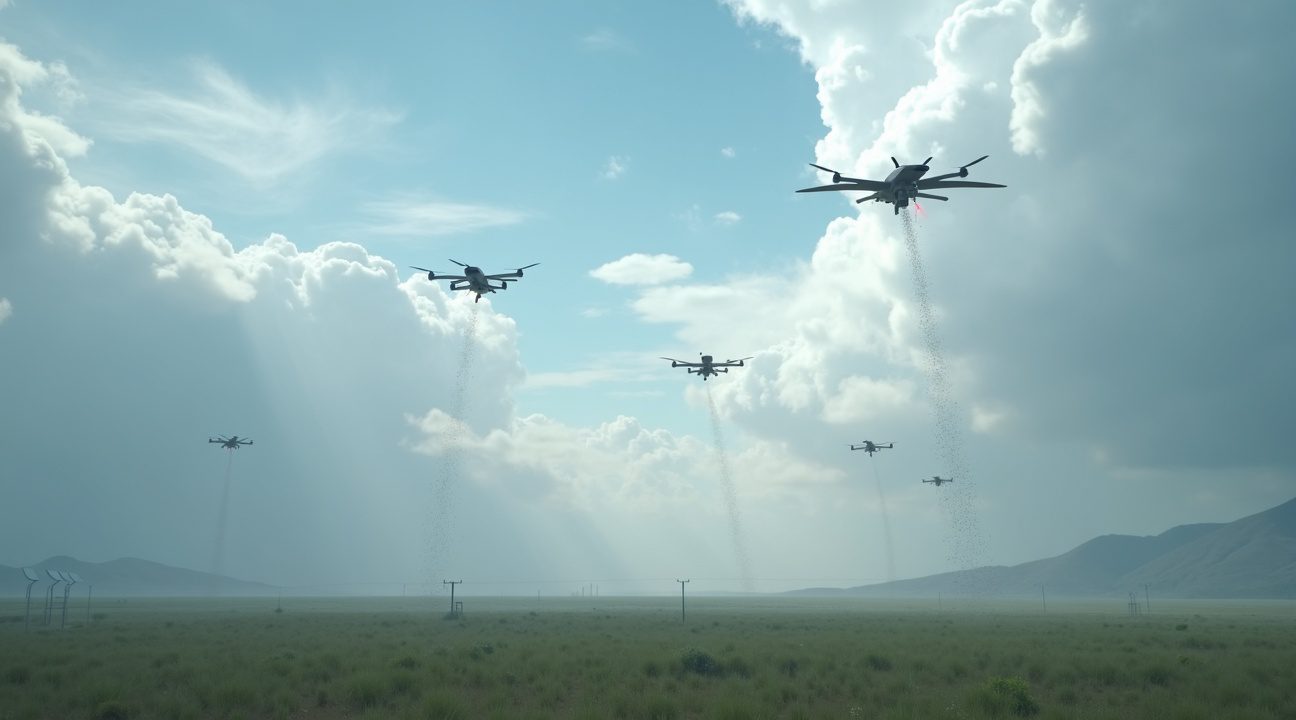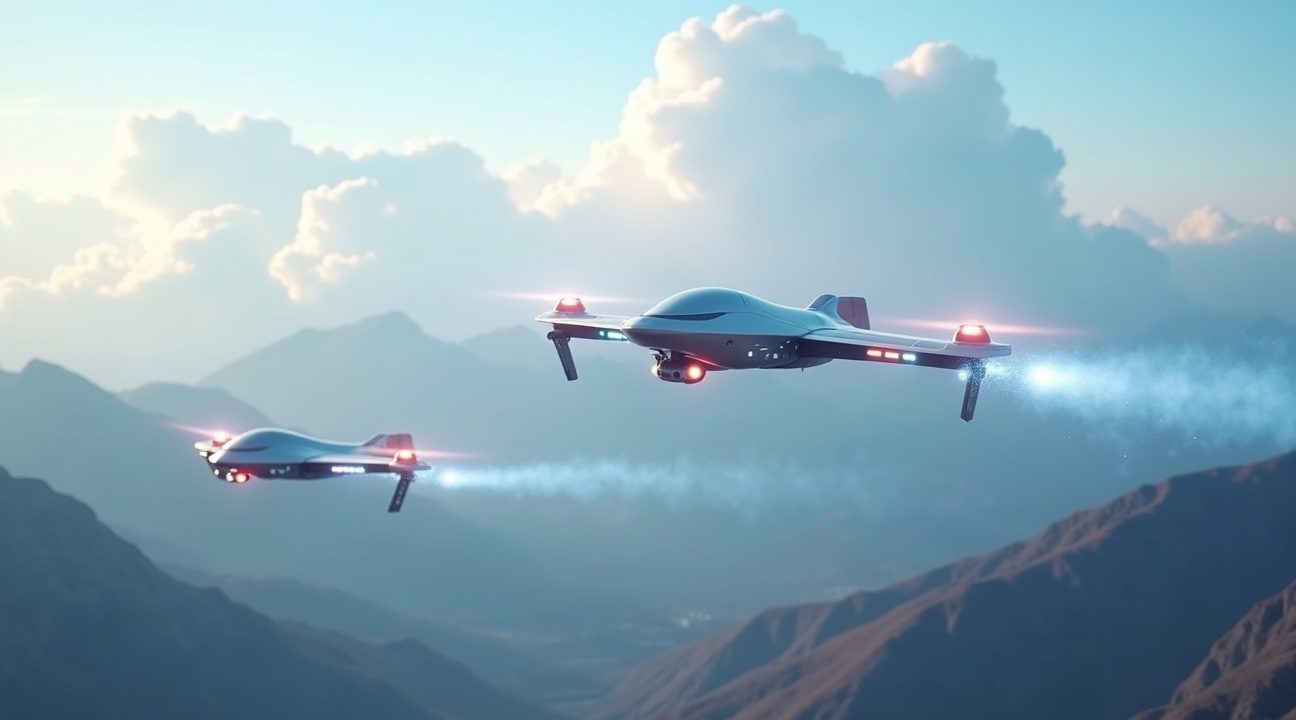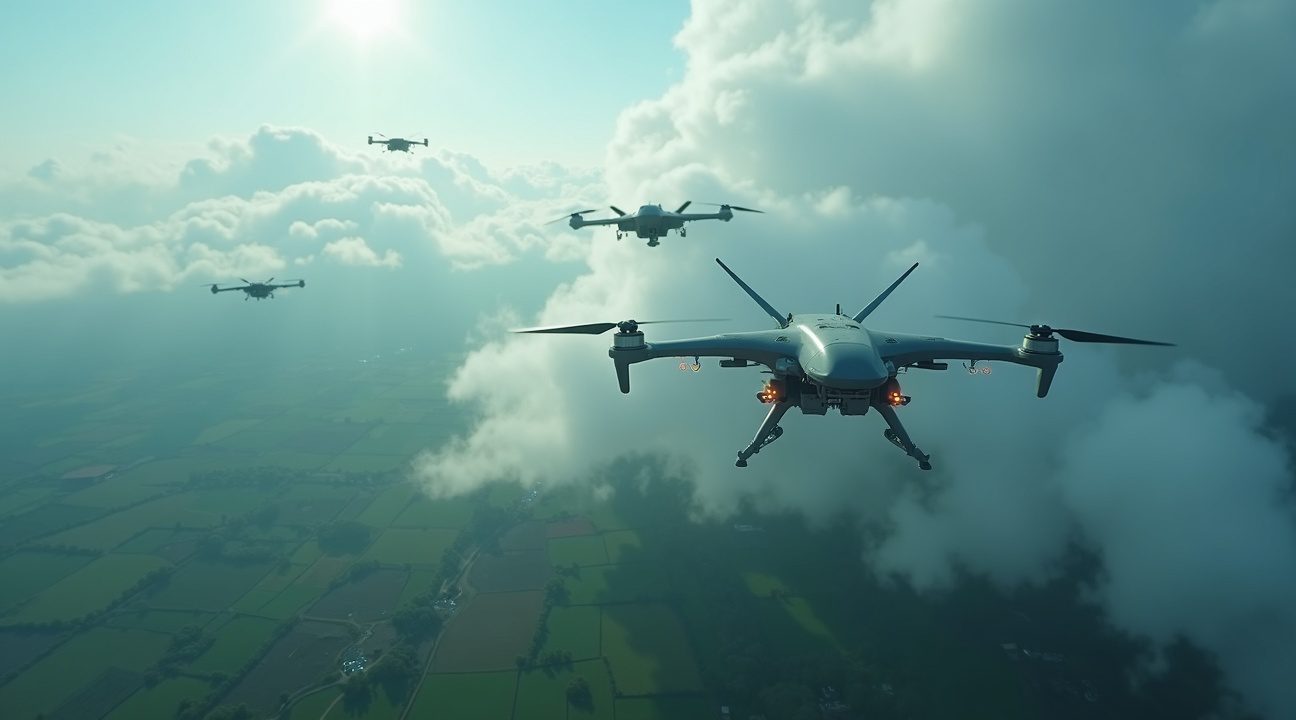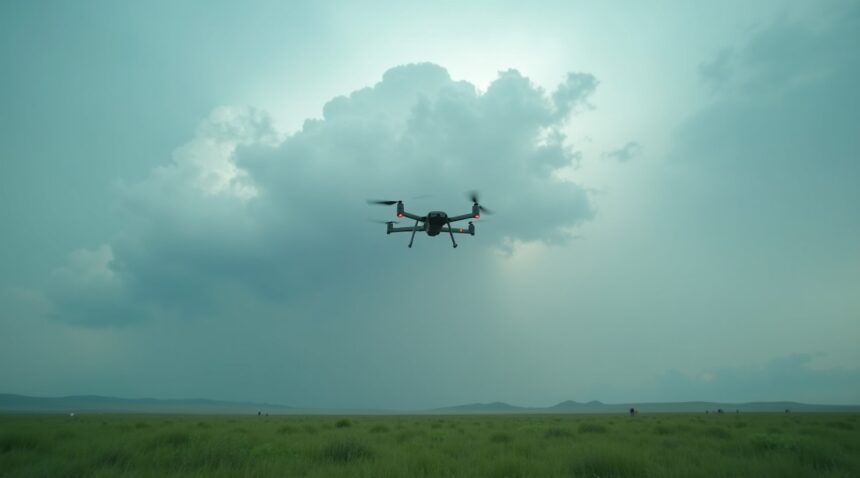China has achieved a breakthrough in weather modification technology with specialized drones that can generate substantial rainfall using minimal resources, marking a significant advancement in the field of atmospheric intervention.
Key Takeaways
- Substantial rainfall increase: A single kilogram of silver iodide dispersed by Chinese drones increased rainfall by over 4% across 3,089 square miles, generating 18.5 million gallons of additional water.
- Advanced monitoring systems: Droplet size increased from 0.46mm to 3.22mm, with a 10°C cooling observed in cloud tops, validating the technology’s effectiveness.
- Largest global program: China operates the world’s most extensive weather modification system using drones, aircraft, rockets, and chemical agents, with operations expanding 20% between 2024–2025.
- Climate resilience for agriculture: The technology aids in securing food production amid climate change by providing targeted rain enhancement in drought-prone areas.
- Regulated and monitored: Operations follow strict safety and environmental protocols, though their strategic nature has prompted concerns about weather manipulation across borders.
Drone-Based Cloud Seeding Efficiency
Chinese scientists have revolutionized cloud seeding through precision drone technology that significantly increases rainfall using minimal chemical inputs. Modern experiments demonstrate that weather modification has transitioned from experimental stages to practical applications, as was evident in the July 2023 trials.
How Silver Iodide Works
Silver iodide particles act as condensation nuclei, offering surfaces for water vapor to condense around and form rain droplets. Chinese drones release these particles at finely calculated altitudes where temperature and humidity are most favorable for precipitation. This precision targeting approach optimizes results while reducing the amount of chemicals required.
Comprehensive Monitoring Technology
An expansive network of ground-based monitoring stations tracks real-time weather data. Laser equipment measures particle dispersion, while microwave detectors evaluate moisture levels inside cloud formations. This robust system ensures accurate performance analysis of rainfall enhancement techniques.
The documented increase in droplet size from 0.46mm to 3.22mm indicates successful cloud nucleation. These larger droplets are more likely to fall as precipitation. Additionally, temperature reductions of up to 10°C in cloud tops confirm higher condensation activity and latent energy release.
Multi-Platform Weather Modification Infrastructure
China’s weather modification network incorporates a variety of delivery platforms:
- Aircraft: Deployed for large-scale seeding over broad geographic regions.
- Rockets: Provide immediate seeding capabilities for sudden weather events.
- Drones: Offer cost-effective, high-precision seeding to targeted areas.
Depending on cloud conditions, dispersal methods involve silver iodide, salt particles, or liquid nitrogen. A 20% operations increase between 2024 and 2025 highlights technological improvements and a growing need for agricultural water solutions.
Applications in Agriculture and Environmental Management
China’s farming sector benefits from the technology during critical growth periods. Targeted rainfall supports crops in drought-stressed areas and enhances grassland restoration. Weather control also aids in water conservation through improved reservoir management.
Safety and Regulatory Considerations
All operations adhere to strict environmental and air traffic regulations. Environmental assessments evaluate the ecological impact, while national frameworks ensure airspace safety. Chemical use is tightly controlled to limit environmental side effects.
Geopolitical and Strategic Dimensions
International observers have raised concerns about potential transboundary effects. Altered weather patterns could unintentionally affect neighboring regions. Diplomatically, China has initiated communication protocols for notifying other nations of substantial weather interventions. However, global legal systems are still adapting to the complexities of atmospheric jurisdiction.
Military and Civil Applications
The technology also draws attention for its strategic military potential and its usefulness in disaster mitigation. On the economic front, increased rainfall can reduce crop insurance claims and bolster water availability for industry.
Future Innovations and Global Outlook
Emerging developments in artificial intelligence may fine-tune seeding operations by predicting optimal deployment times and locations. Integrating satellite data could dramatically improve monitoring accuracy. In the future, international collaboration frameworks may help standardize and responsibly expand global weather modification efforts.
China’s advancement in drone-based weather modification showcases a scalable and efficient model that is already producing measurable environmental benefits. With robust data collection and efficient resource use, the nation sets a new standard for sustainable geoengineering practices.
China Creates Rain from Just One Kilogram of Silver Iodide
China’s cloud-seeding technology reached a significant milestone during a field experiment conducted over Xinjiang’s Bayanbulak Grasslands on July 9, 2023. The demonstration showcased how a single kilogram of silver iodide could transform weather patterns across vast expanses of land.
Extraordinary Results from Minimal Materials
The experiment delivered results that exceeded expectations. Just 2.2 pounds of silver iodide dispersed by specialized drones increased rainfall by over 4% across an area spanning 8,000 square kilometers. This coverage equals roughly 3,089 square miles of grassland receiving enhanced precipitation.
The volume of additional rain generated from this small amount of seeding material was substantial. Scientists calculated that the single kilogram produced more than 70,000 cubic meters of extra rainfall. To put this in perspective, that’s equivalent to 18.5 million gallons of water—enough to fill 30 Olympic-sized swimming pools completely.
These numbers demonstrate the extraordinary efficiency of modern cloud-seeding techniques. Traditional methods often required significantly more materials to achieve similar results across smaller areas. The precision of drone deployment allows for targeted application that maximizes the effectiveness of each gram of silver iodide used.
Scientific Validation Through Advanced Monitoring
Multiple monitoring systems tracked the experiment’s progress and validated its success. Advanced raindrop spectrometers provided real-time measurements that confirmed the cloud-seeding process was working as intended.
The spectrometers recorded dramatic changes in droplet characteristics:
- Initial droplet sizes measured 0.46mm in diameter before seeding
- Post-seeding droplets expanded to 3.22mm in diameter
- This seven-fold increase in droplet size directly correlated with enhanced precipitation rates
- Larger droplets fall faster and more efficiently, improving overall rainfall effectiveness
Satellite imagery provided additional confirmation of the cloud response. Temperature readings from space revealed a 10°C cooling of cloud tops, indicating increased vertical development within the cloud structure. This cooling pattern signals enhanced convective activity—a key indicator that cloud-seeding efforts are successfully modifying atmospheric conditions.
The satellites also tracked vertical cloud growth, measuring an expansion of 1.8 miles upward. This dramatic increase in cloud height demonstrates how silver iodide particles serve as nucleation points, encouraging water vapor to condense and form precipitation-ready droplets.
Ground-based weather stations throughout the test area recorded consistent increases in rainfall amounts. The 4% enhancement might seem modest, but across such a vast area, it represents millions of gallons of additional water resources. For agricultural regions like Xinjiang’s grasslands, this level of precipitation boost can significantly impact crop yields and livestock grazing conditions.
The timing of the experiment proved ideal for demonstrating effectiveness. July conditions in Xinjiang typically feature suitable atmospheric moisture levels and cloud formations that respond well to seeding efforts. Weather conditions allowed researchers to isolate the effects of the silver iodide from natural rainfall variations.
This successful demonstration builds upon decades of cloud-seeding research in China. The country has invested heavily in weather modification technology, recognizing its potential for addressing water scarcity issues and supporting agricultural productivity. The Bayanbulak Grasslands experiment represents a significant step forward in operational cloud-seeding capabilities.
The precision achieved through drone deployment offers advantages over traditional aircraft-based seeding methods. Drones can operate at lower altitudes, target specific cloud formations more accurately, and reduce operational costs. They also provide safer alternatives for weather modification activities, eliminating risks associated with piloted aircraft flying through potentially turbulent weather conditions.
Results from this experiment will likely influence future cloud-seeding operations across China and internationally. The demonstrated efficiency of silver iodide deployment through drones could inspire similar programs in other regions facing water shortage challenges. Much like unusual weather phenomena such as strange precipitation events, cloud-seeding technology continues to push the boundaries of what’s possible in atmospheric science.

Revolutionary Drone Technology Transforms Weather Modification Operations
China’s latest weather modification program deploys two specialized medium-sized drones engineered to reach altitudes of 5,500 meters (18,000 feet) while maintaining extended operational periods. These unmanned aerial vehicles represent a significant advancement over conventional cloud-seeding methods, combining cutting-edge remote-sensing capabilities with practical efficiency improvements.
Advanced Detection and Monitoring Systems
The drones integrate multiple sophisticated technologies that enhance their weather modification effectiveness:
- Laser-microwave dual detection systems provide precise atmospheric measurements
- Active and passive in-situ detection capabilities monitor real-time conditions
- Comprehensive weather monitoring equipment tracks environmental changes throughout operations
- Real-time data transmission enables immediate adjustments to seeding strategies
I find these technological integrations particularly impressive because they allow operators to make data-driven decisions during active missions. Traditional aircraft often rely on pre-flight weather assessments, but these drones continuously adapt their approach based on current atmospheric conditions.
The operational advantages extend beyond technology alone. These UAVs deliver substantial cost savings compared to legacy aircraft systems through rapid deployment capabilities and significantly reduced operational expenses. Where conventional cloud-seeding operations require extensive preparation time and costly aircraft maintenance, drone systems can launch within hours of weather identification.
Perhaps most striking is the efficiency of material consumption. A single day’s drone operation requires only a travel mug-sized volume of silver iodide to achieve rainfall outputs that match or exceed older systems. This dramatic reduction in seeding material costs, combined with lower fuel and maintenance requirements, makes weather modification operations more economically viable for regular use.
The extended flight duration capability allows these drones to remain airborne for hours, continuously monitoring and adjusting their seeding patterns as weather conditions evolve. This persistence enables more thorough cloud treatment compared to traditional aircraft that must return to base for refueling more frequently.
While some might draw parallels to other unusual weather phenomena like worm rain that recently confused locals, these drone operations represent deliberate scientific intervention rather than mysterious natural occurrences. The technology’s precision allows meteorologists to target specific cloud formations and atmospheric conditions with unprecedented accuracy.
The deployment flexibility of these systems means weather modification can occur in previously inaccessible areas or during conditions that would ground traditional aircraft. Remote mountainous regions, areas with challenging terrain, or locations with limited airport infrastructure no longer present barriers to cloud-seeding operations.

World’s Largest Weather Modification Program Delivers Massive Results
China operates the most extensive weather modification program on the planet, dwarfing similar initiatives worldwide through its sophisticated integration of aircraft, drones, rockets, and specialized chemical agents. This comprehensive system targets specific regions for rain generation, hail suppression, and snow enhancement with unprecedented scale and precision.
Impressive Growth in Precipitation Operations
Recent data reveals the program’s remarkable expansion and effectiveness. Between late May and early June 2025, ground-based precipitation enhancement operations increased by 20% compared to the previous year. This surge in activity directly translated into substantial results, generating nearly a third more rainfall across participating provinces.
The program’s success stems from its multi-tiered approach that coordinates efforts at national, regional, and local levels. Since establishing the Weather Modification Centre in 2021, China has streamlined operations to maximize efficiency and impact. This centralized coordination allows for rapid deployment of resources where they’re needed most, whether addressing drought conditions or preventing crop-damaging hail.
Strategic Regional Focus and Advanced Technology
Operations concentrate on six key regions: Xinjiang, Inner Mongolia, Shaanxi, Shanxi, Ningxia, and Gansu. These areas serve both agricultural and ecological purposes, supporting crop production while restoring damaged ecosystems. The strategic selection of these provinces reflects China’s commitment to addressing water scarcity in areas critical to food security and environmental restoration.
The National Air-Ground Communication System represents a technological breakthrough in weather modification coordination. This sophisticated network enables real-time synchronization between airborne and ground operations, ensuring optimal timing and placement of precipitation enhancement activities. Pilots can communicate instantly with ground crews, adjusting flight patterns and chemical deployment based on live meteorological data.
Modern drones play an increasingly important role in these operations, offering precision that traditional aircraft cannot match. These unmanned systems can access remote areas, operate in challenging weather conditions, and deploy chemical agents with surgical accuracy. The combination of traditional aircraft and cutting-edge drone technology creates a flexible response system capable of addressing diverse weather modification needs.
Chemical agents used in the program include silver iodide and other cloud-seeding materials that encourage precipitation formation. Ground-based rockets and aircraft deliver these substances into cloud formations, triggering condensation processes that lead to rainfall or snowfall. The timing and placement of these operations require careful coordination with meteorological forecasts to maximize effectiveness.
Hail suppression represents another critical component of the program, protecting agricultural regions from destructive storms. By deploying specific chemicals at precise altitudes, operators can reduce hail formation or minimize hail size, saving millions of dollars in crop damage annually. This protective capability proves especially valuable during vulnerable growing seasons when a single hailstorm could devastate entire harvests.
Snow enhancement operations support winter tourism and water resource management in mountainous regions. Increased snowpack provides crucial water reserves for spring and summer months, supporting both urban water supplies and agricultural irrigation systems. These operations demonstrate how weather modification serves multiple economic and environmental objectives simultaneously.
International observers study China’s weather modification program closely, recognizing its potential applications for addressing climate challenges globally. The scale and sophistication of operations provide valuable insights for other nations considering similar initiatives. As extreme weather events become more frequent, such programs may become essential tools for agricultural resilience and water security.
The success of China’s weather modification program reflects years of research, technological development, and operational refinement. Weather anomalies in China continue to capture global attention as the country pushes boundaries in atmospheric intervention. This massive undertaking demonstrates how coordinated efforts can achieve meaningful results in weather modification, setting new standards for precipitation enhancement worldwide.
Fighting Climate Change and Food Security Through Artificial Rain
China’s ambitious weather modification program addresses critical challenges that threaten the nation’s ability to feed its massive population. Climate change has intensified drought conditions across the country’s arid northern and western regions, creating urgent demands for innovative solutions that can secure agricultural productivity.
The high-tech drone program focuses primarily on rain enhancement for agricultural zones, where traditional farming methods struggle against increasingly unpredictable weather patterns. Farmers in these drought-prone areas have witnessed dramatic improvements in crop yields when artificial rain supplements natural precipitation. The technology proves particularly valuable during critical growing seasons when water scarcity can devastate entire harvests.
Protecting Agricultural Regions Through Strategic Water Management
China’s weather modification efforts concentrate on specific agricultural regions that face the greatest threats from climate change. These areas include:
- Northern provinces where traditional wheat production has declined due to extended dry periods
- Western territories where pastoral communities depend on consistent rainfall for livestock grazing
- Mountain regions where snowpack enhancement can improve downstream water availability for irrigation
- Coastal agricultural zones experiencing altered precipitation patterns from changing ocean currents
Water resource management becomes increasingly critical as China’s population continues to place enormous pressure on available freshwater supplies. The artificial rain program helps bridge the gap between natural precipitation and agricultural water demands, particularly in regions where groundwater depletion has reached alarming levels.
Advanced drone technology allows meteorologists to target specific agricultural areas with precision timing, ensuring that rain enhancement occurs when crops need moisture most. This strategic approach maximizes the effectiveness of cloud seeding operations while minimizing waste of valuable resources. The drones can operate in challenging weather conditions that would ground traditional aircraft, providing consistent support throughout growing seasons.
Climate scientists recognize that weather modification represents just one component of a comprehensive approach to food security. However, the technology offers immediate relief for farmers facing drought conditions that could otherwise result in crop failures. Early results from pilot programs show promising increases in agricultural productivity across treated regions.
The program’s emphasis on food security reflects China’s broader strategy to maintain agricultural self-sufficiency despite environmental challenges. As global climate patterns continue shifting, artificial rain technology provides a buffer against extreme weather events that threaten crop production. This capability becomes especially important as unusual weather phenomena become more frequent across the region.
Research data suggests that targeted rain enhancement can increase precipitation by 15-20% in treated areas during optimal conditions. Such improvements translate directly into higher crop yields and improved food security for millions of people who depend on domestic agricultural production. The technology proves most effective when combined with improved irrigation systems and drought-resistant crop varieties.
China’s investment in weather modification technology reflects recognition that climate change poses existential threats to agricultural sustainability. Traditional farming practices alone cannot adapt quickly enough to rapidly changing environmental conditions. Artificial rain programs provide agricultural communities with tools to maintain productivity despite increasing weather volatility.
The success of these programs depends on careful coordination between meteorological services, agricultural planners, and local farming communities. Real-time weather monitoring systems guide drone deployment decisions, ensuring that cloud seeding operations occur under optimal atmospheric conditions. This integrated approach maximizes the return on investment while building resilience into China’s agricultural systems.
Future expansion of the weather modification program aims to cover additional agricultural regions where drought threatens food production. The technology’s potential to support climate adaptation strategies makes it an essential component of China’s long-term food security planning. As extreme weather events become more common, artificial rain capabilities offer critical protection for the agricultural sector that feeds the world’s largest population.
Safety Standards and Environmental Governance Shape Operations
China’s weather modification program operates under strict national safety standards that govern the deployment and operation of high-tech drones designed for rain creation. These comprehensive regulations cover all weather modification tools, including specialized rockets, drones, and chemical agents used in cloud seeding operations. These standards aren’t just guidelines—they’re enforced requirements that shape how operators conduct their missions.
Compliance Requirements Drive Operational Protocols
The regulatory framework mandates routine verification processes for all weather modification equipment and personnel. Operators must demonstrate compliance with established laws regarding the transport and use of hazardous materials, particularly the silver iodide and other chemical agents deployed during cloud seeding operations. These verification procedures ensure that drone systems meet technical specifications and that operators possess the necessary certifications to handle potentially dangerous substances.
Safety protocols extend beyond equipment checks to include:
- Detailed documentation of chemical storage
- Transportation routes
- Deployment procedures
Each mission requires pre-flight safety assessments and post-operation reports that track chemical usage and environmental conditions. This systematic approach helps prevent accidents while maintaining operational effectiveness across China’s vast weather modification network.
Environmental Oversight Follows General Framework
Environmental assessments for weather modification activities fall under China’s broader environmental protection laws rather than specialized weather modification regulations. This approach means that environmental impact evaluations follow the same procedures used for other industrial activities, focusing on:
- Air quality
- Water contamination
- Ecosystem effects
However, the unique nature of weather modification presents challenges that standard environmental frameworks don’t always address comprehensively.
Administrative oversight includes monitoring systems that track the frequency and intensity of weather modification operations across different regions. These systems help prevent over-modification of weather patterns that could disrupt natural precipitation cycles or create unintended environmental consequences. The monitoring extends to tracking chemical dispersal patterns and assessing potential accumulation in soil and water systems.
Limited transparency characterizes China’s approach to sharing information about weather modification activities, particularly with neighboring countries. While domestic safety and compliance data receives regular review, international disclosure of operational details remains restricted. This approach creates challenges for regional weather coordination and raises questions about cross-border environmental effects.
The governance structure separates safety monitoring from environmental assessment, creating distinct oversight pathways for different aspects of weather modification operations.
- Safety standards focus on immediate operational risks and equipment reliability
- Environmental governance addresses longer-term ecological impacts
This division sometimes creates gaps in comprehensive oversight, particularly for activities that span both safety and environmental concerns.
Chemical agent regulations require special handling procedures for substances used in cloud seeding operations. These materials must be:
- Transported using certified vehicles
- Stored in approved facilities
- Deployed by trained personnel following established protocols
The regulations also specify disposal procedures for unused chemicals and contaminated equipment, ensuring that hazardous materials don’t accumulate in operational areas.
Weather modification operations in China demonstrate how a structured regulatory approach can enable large-scale technological deployment while maintaining safety standards. The system balances operational flexibility with compliance requirements, allowing operators to respond to weather conditions while following established safety protocols. Environmental phenomena associated with weather modification continue to evolve as technology advances and deployment scales increase.
The regulatory framework continues adapting to accommodate new technologies and operational methods. Recent updates have addressed drone-specific safety requirements and expanded environmental monitoring capabilities. These changes reflect the growing sophistication of weather modification technology and the need for governance structures that can keep pace with technological advancement.

Strategic Weather Control Builds on Olympic Success
China’s current drone-based rain generation technology represents a significant evolution from the weather modification techniques successfully deployed during major international sporting events. The country first showcased its weather control capabilities during the 2008 Beijing Olympics, where authorities used cloud seeding operations to prevent rainfall during opening ceremonies and key competitions. These efforts proved so effective that China expanded the program for the 2022 Winter Olympics, demonstrating consistent mastery over precipitation patterns across different seasons and weather conditions.
Military Applications Draw International Attention
The transition from event-specific weather management to advanced drone technology has captured the attention of military strategists worldwide. These high-tech systems offer unprecedented precision in targeting specific geographic areas for rain generation, creating possibilities that extend far beyond agricultural applications. Defense analysts recognize that strategic weather modification could influence everything from battlefield conditions to regional water resources, potentially affecting neighboring countries without traditional military engagement.
International law experts have begun examining the implications of transboundary weather modification, particularly when artificial precipitation in one region might affect rainfall patterns in adjacent territories. Military use of such technology raises questions about environmental warfare and the need for new international agreements governing weather modification capabilities.
Geopolitical Implications of Weather Control
The diplomatic community has expressed growing concern about the strategic implications of China’s advancing weather modification technology. Countries sharing borders or downstream water resources worry that artificial rain generation could alter natural precipitation patterns, affecting agricultural cycles and water supplies beyond China’s borders. This concern becomes particularly relevant in regions already experiencing water stress or climate-related challenges.
Strategic weather modification capabilities also present new dynamics in international relations, where control over precipitation could become a tool of soft power or economic influence. The technology’s potential to alleviate drought conditions in friendly nations while potentially affecting weather patterns in others creates complex diplomatic considerations that traditional international frameworks haven’t fully addressed.
China’s investment in high-tech drone systems demonstrates a commitment to expanding weather control capabilities beyond the temporary measures used during the Olympics. Unlike the large-scale operations required for major events, these drones offer targeted, flexible deployment options that could be activated for various strategic purposes. The precision and mobility of drone-based systems represent a significant advancement over traditional cloud seeding methods, allowing for more localized and controlled weather modification efforts.
The success of Olympic weather management programs provided valuable data and operational experience that now informs the development of these advanced drone systems. Lessons learned from preventing rain during high-profile international events have been applied to create technology capable of generating precipitation on demand, marking a complete reversal of the original Olympic applications.
As China continues developing this technology, international observers note the potential for weather modification to become a standard tool in both civilian and military applications. The ability to create rain anywhere on demand could reshape agricultural practices, disaster response strategies, and even regional power dynamics. Some experts draw parallels to other unusual weather phenomena, such as worm rain events that have previously mystified local populations, highlighting how weather-related phenomena continue to surprise and challenge our understanding of atmospheric systems.
The progression from Olympic weather prevention to strategic precipitation control illustrates China’s systematic approach to environmental modification technology. This evolution reflects broader ambitions to harness natural processes for national objectives, whether addressing domestic water security concerns or projecting influence through environmental capabilities. Military and diplomatic communities worldwide continue monitoring these developments, recognizing that weather modification technology could fundamentally alter how nations interact with both their environment and each other.

Sources:
ThomasNet Insights: Cloud-Seeding Drones Make It Rain in China’s Driest Region
State Council of the People’s Republic of China: China develops detection drone for weather modification
UAS Vision: One Cup of Cloud Seed Makes 30 Swimming Pools of Rain
UNN: China is using chemicals to stimulate rain in the country’s arid regions
South China Morning Post: China’s weather modification test: Cup of cloud seed makes 30 swimming pools of rain
Cambridge University Press (Transnational Environmental Law): Transboundary Implications of China’s Weather Modification Programme
Bloomberg: China Steps Up Cloud Seeding to Boost Rain in Dry Wheat Regions
Mad Scientist Blog (US Army TRADOC): 355. Shén fēng: Military Use of Weather Modification Technology


